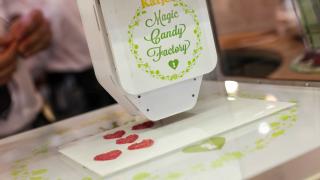
Katjes Magic Candy Factory is the world’s first 3D candy printer which allows customers to create fully customizable treats. The incredibly dedicated team at Katjes Fassin UK Ltd - led by Founder & Head Magician Melissa Snover - worked hard for many months, to create a way for children and adults alike, to print all of their heart’s desires. The magic candy factory prints gummy candy in the same way that a Fused deposition modeling printer prints plastic objects. What's more, the 3d printers themselves are some of the quickest in the world, printing candy in less than 5 minutes - What a wonderful word we now live in!
This led me down a Willy Wonka inspired path, delving deeper into the world of additive manufacturing, wondering if there are any limitations to this process given the recent advances in the field.
The advent of additive manufacturing - or 3D printing as it’s commonly known -has seen an explosion of products (designed in digital environments), involving levels of complexity which simply could not be produced physically in any other way. It has made a significant impact on industrial applications, whereby parts are being developed to replicate complex components that are both lighter and stronger than their predecessors. Notably, the aerospace industry has taken a particular shine to 3D printing, where these factors are of primary importance.
The 3D printing process also allows for mass customisation — the ability to personalise products according to individual needs and requirements. Even within the same build chamber, the nature of 3D printing means that numerous products can be manufactured at the same time, with no additional costs.
For industrial manufacturing, one of the most cost-intensive, time-intensive and labor-intensive stages of the product development process is, of course, the production of the tools. For low to medium volumes, additive manufacturing can eliminate the need for tooling altogether, thereby reducing all of the aforementioned. It goes without saying that this is an extremely attractive proposition and one that an increasing number of manufacturers are already taking advantage of. Furthermore, because of the complexity advantages, products and components can be designed specifically to avoid assembly requirements.
Rightly so, 3D printing is emerging as an energy-efficient technology that can provide environmental efficiencies in the manufacturing process itself, utilising up to 90% of standard materials and therefore, creating less waste. However, this is not the only advantage. A component produced by additive manufacturing is typically a lighter and stronger design that imposes a reduced carbon footprint, when compared with traditionally manufactured products.

So, what are the limitations with materials? A growing number of metals and metal composites are currently used for industrial 3D printing. Two of the most common are aluminium and cobalt derivatives, with powder-form stainless steel offering a more durable solution - usually within the sintering/melting/EBM processes. In the last couple of years, powder-form gold and silver have been added to the range of metal materials that can be 3D printed directly, with titanium also having been used to create robust components that are more than fit for purpose.
Strong and flexible plastics such as Nylon are commonly used in powder form and when combined with powdered aluminium, Nylon also produces another common 3D printing material — Alumide. ABS, which comes in a wide range of colours, is another commonly-used plastic, usually on the entry-level 3D printers in filament form. The use of PLA facilitates a bio-degradable solution that has gained traction with 3D printing for this very reason. It can be utilised in resin format; however, it is not as durable or as flexible as its ABS counterparts. From further research I also found mention of LayWood, which is a specially developed 3D printing material. This wood polymer composite (also referred to as WPC), is the only wood material currently used within 3D Manufacturing.
But perhaps the most exciting material of all: vegan, gluten-free & dairy free Gelatine!
Since it was founded in April 2015, Katjes Magic Candy Factory have become world famous for their ground-breaking developments in customised candy. Their innovation has been honoured with many awards including the ‘Free From Food Award 2016’, First prize in the ‘Top Innovation Award 2016’ and winner of the ‘World Food Innovation 2016’.
As with any process, there are of course limits to what additive manufacturing can produce, but with a sprinkle of innovation and a dash of creativity, it seems that anything is possible!
